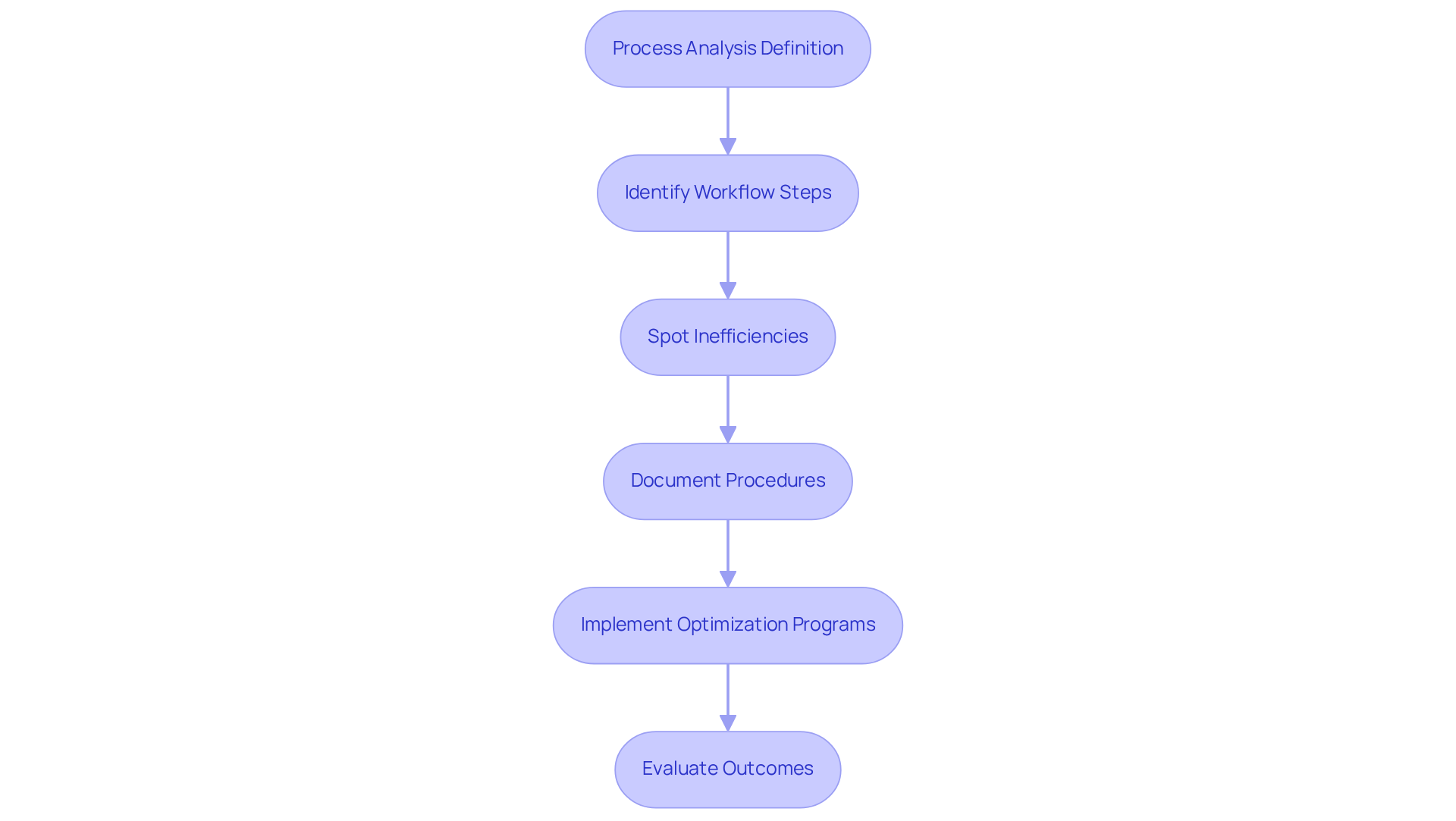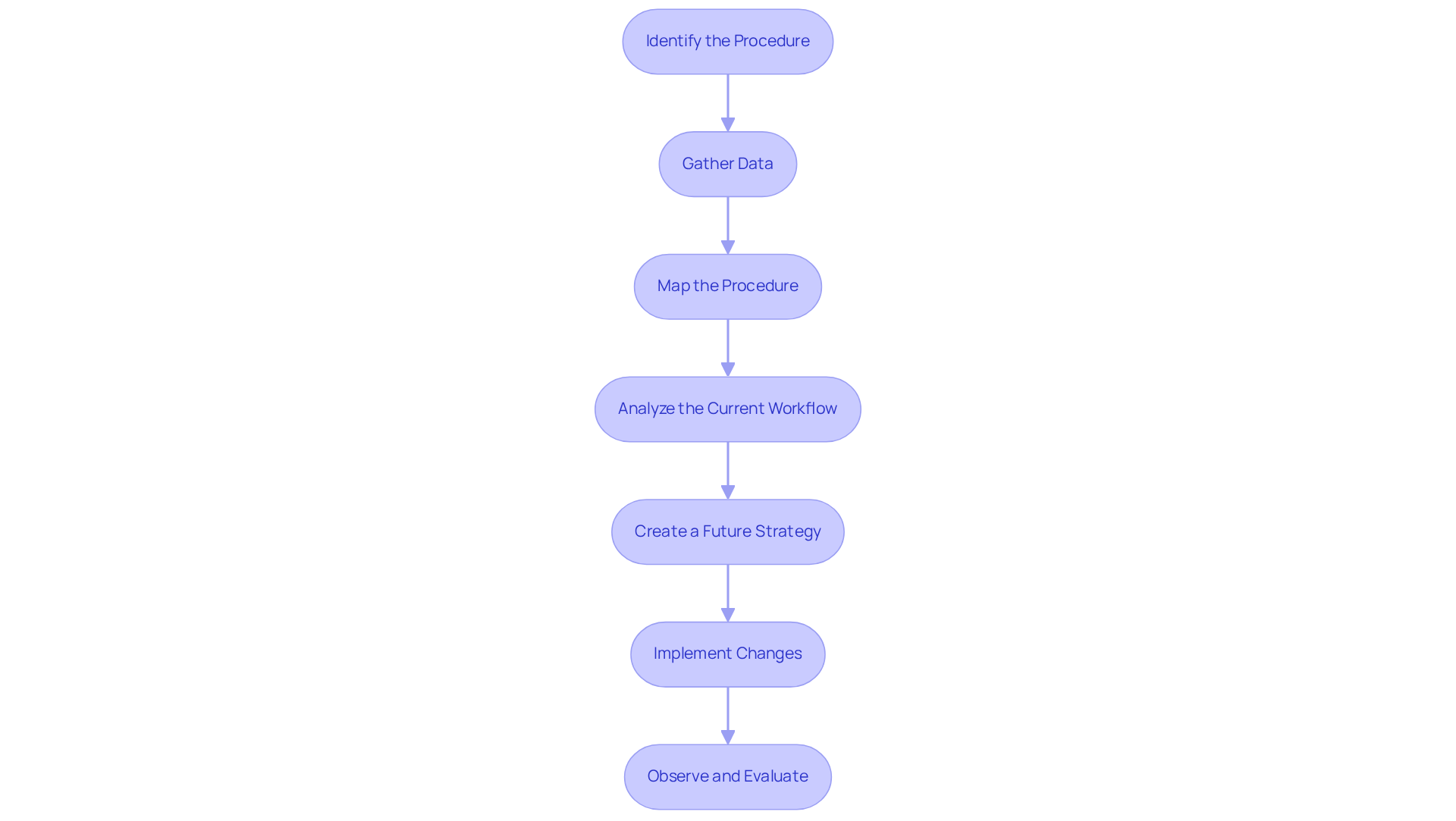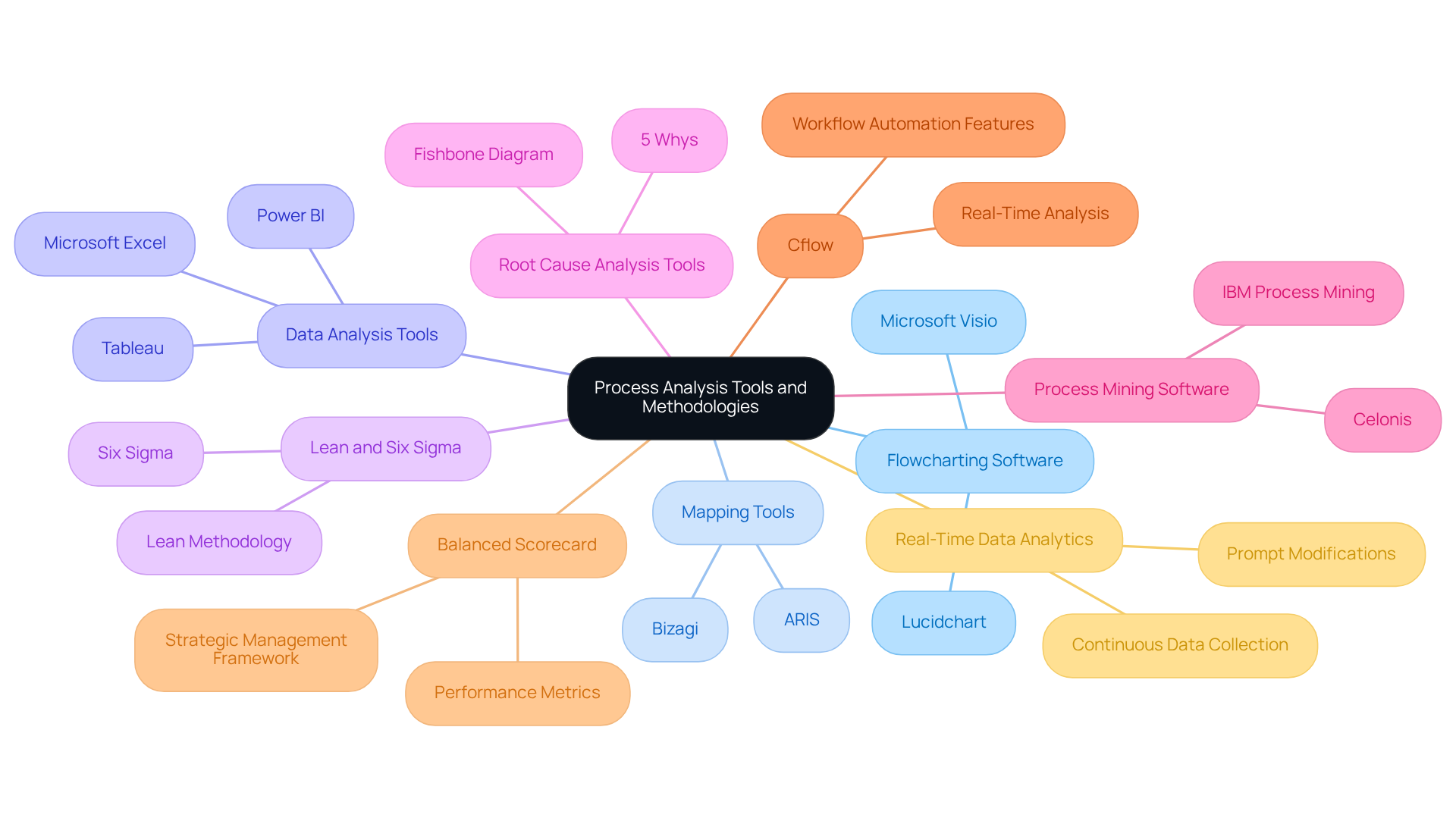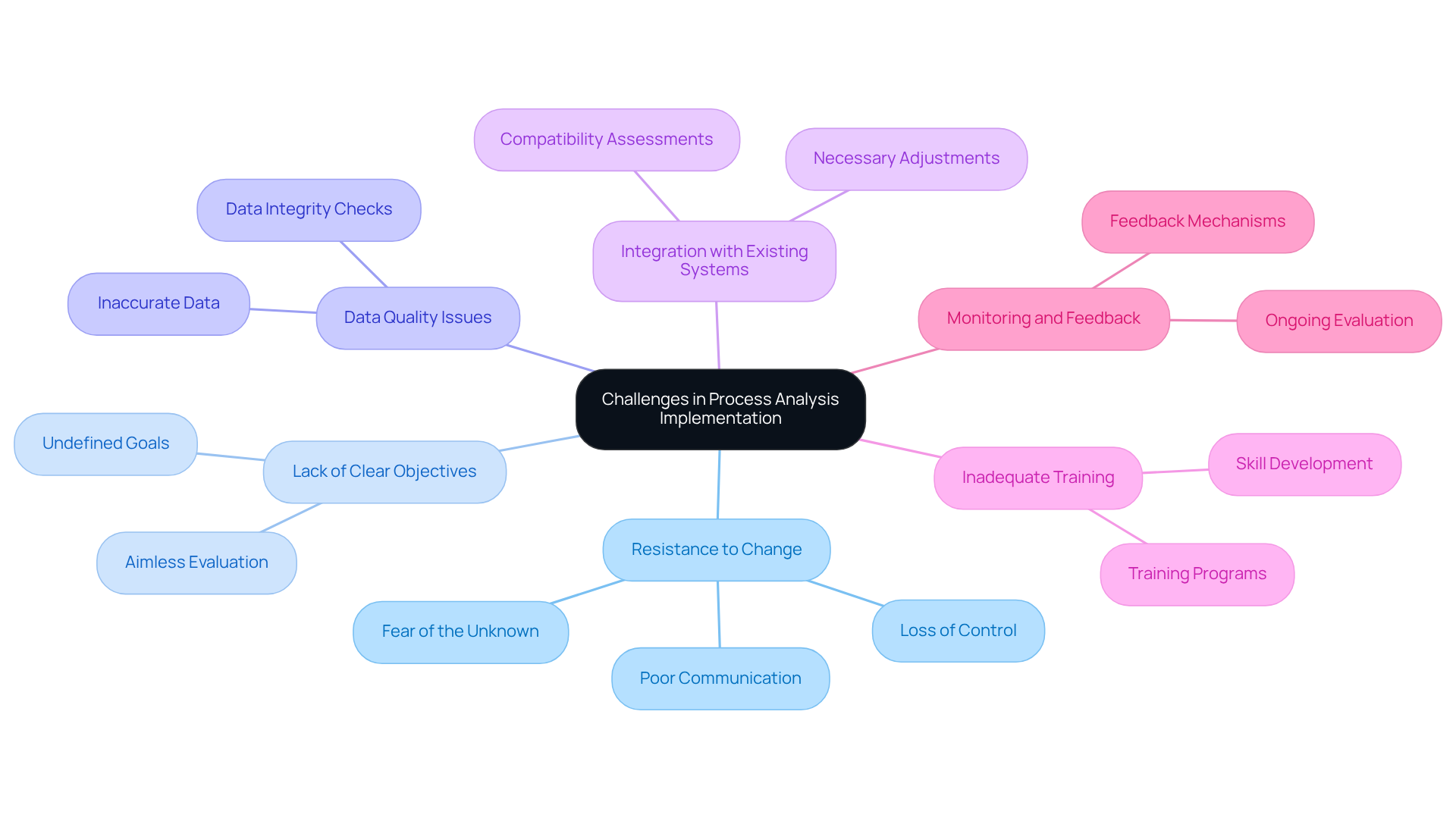
Process Improvement through Documentation
|
October 17, 2025
|
Process Analysis Definition: Key Steps and Tools for Success
Overview
You might be wondering what process analysis really is. Well, it's all about taking a systematic look at the steps in your workflow. The goal? To spot inefficiencies and find areas where you can improve. This can lead to some pretty significant reductions in operational costs and even boost revenue per employee!
So, how do you go about conducting effective process analysis? It starts with mapping out your procedures and making necessary changes. But, of course, there are some essential tools you'll want to have in your toolkit, along with challenges that might pop up along the way. This is why a structured evaluation is so important for achieving operational excellence. Now, let’s dive into how you can make this work for you!
Key Highlights:
- Process analysis involves a systematic examination of workflow steps to identify inefficiencies and areas for improvement.
- Effective process analysis can lead to significant operational cost reductions (25-30%) and increased revenue per employee (20-30%).
- Key steps in conducting process analysis include identifying the procedure, gathering data, mapping the procedure, analysing the current workflow, creating a future strategy, implementing changes, and observing outcomes.
- Tools for process analysis include flowcharting software, mapping tools, data analysis tools, Lean and Six Sigma methodologies, root cause analysis tools, and real-time data analytics.
- Challenges in implementing process analysis include resistance to change, lack of clear objectives, data quality issues, integration with existing systems, inadequate training, and the need for ongoing monitoring and feedback.
Introduction
You might be wondering how understanding process analysis can really change the game for your organization. Well, it’s all about efficiency and productivity! By breaking down workflows step by step, businesses can spot inefficiencies and grab hold of opportunities for improvement. This can lead to big savings on operational costs and a nice boost in revenue. But what happens when resistance to change or unclear goals gets in the way? In this article, we’ll dive into the essential steps and tools for successful process analysis, giving you the knowledge to tackle these challenges and enhance your operational excellence.
Define Process Analysis: Key Concepts and Importance
You might be wondering what the process analysis definition really is. Well, it’s a systematic look at the steps in a workflow, which is a clear example of the process analysis definition, aimed at understanding how things work and spotting areas that could use a little TLC. By breaking down each step, organizations can uncover inefficiencies, bottlenecks, and golden opportunities for improvement. This is super important for boosting operational efficiency because it helps businesses streamline their operations, allocate resources better, and ultimately ramp up productivity.
For example, companies that jump on structured optimization programs often see a 25-30% drop in operating costs and a 20-30% boost in revenue per employee. Pretty impressive, right? And get this: financial organizations that digitized over 70% of their key workflows noticed a whopping 31% reduction in operational expenses. That’s the real deal when it comes to the benefits of evaluating workflows.
The insights gained from the process analysis definition of these systems are key to rolling out efficient methods that drive ongoing improvement and operational excellence. Plus, effective documentation of procedures is a crucial first step in this evaluation process, helping organizations spot weaknesses and inconsistencies in their designs. Just look at JURA Materials; their savvy use of analytical methods shows how businesses can enhance their operational excellence and adapt to market changes. So, what are you waiting for? Let’s dive into the world of process analysis together!

Outline Steps for Conducting Effective Process Analysis
- Identify the Procedure: So, you’re ready to dive in! Start by picking the specific procedure you want to analyze. It’s important to clearly define the boundaries and objectives in the context of the process analysis definition. As Peter Drucker wisely said, "Efficiency is doing things right; effectiveness is doing the right things," which really highlights the need for a focused approach.
- Gather Data: Next up, let’s talk about data collection. You’ll want to gather relevant information about the current procedure, like cycle times, error rates, and resource utilization. Remember, effective data collection is crucial for informed decision-making, as noted in the "Five things learned from PEX Report 2022."
- Map the Procedure: Now, how about creating a visual representation of the procedure? Using flowcharts or diagrams can really help you understand the sequence of actions and decision points. The SowFlow Documentation System is a great example of how effective documentation can simplify workflows, making this step even clearer.
- Analyze the Current Workflow: Let’s take a moment to assess the outlined procedure. This is where the process analysis definition helps you identify inefficiencies, bottlenecks, and areas for enhancement. It’s a crucial evaluation that’s vital for informed decision-making and aligns with the philosophy of ongoing development.
- Create a Future Strategy: Based on your evaluation, sketch out a plan for enhancing the workflow. This should include specific actions to tackle the issues you’ve identified, ensuring you have a clear path forward.
- Implement Changes: Time to put your plan into action! Make sure to execute the changes you’ve outlined, keeping all stakeholders informed and involved. Effective communication is key to successful implementation, as highlighted in various case studies.
- Observe and Evaluate: After executing your plan, it’s important to keep an eye on the system. Consistently oversee it to ensure the enhancements are effective and make modifications as needed. And remember, as Jack Welch said, "Change before you have to," which really underscores the importance of proactive monitoring.

Explore Tools and Methodologies for Process Analysis
You might be wondering what tools and methodologies can really make a difference in the process analysis definition. Well, there’s quite a variety out there that can help you out!
First up, we have Flowcharting Software. Applications like Lucidchart and Microsoft Visio let you create detailed flowcharts that visually represent processes. This makes it so much easier for everyone to understand and communicate about what’s going on.
Then there are Mapping Tools like Bizagi and ARIS. These handy tools help you chart out workflows, making it easier to spot inefficiencies and areas that could use a little enhancement.
Don’t forget about Data Analysis Tools! Instruments such as Tableau and Microsoft Excel are essential for handling data, creating pivot tables, and doing statistical examinations. They help organizations analyze the information gathered during the process, keeping an eye on key performance indicators and revealing trends.
Now, let’s talk about Lean and Six Sigma Methodologies. These structured approaches focus on eliminating waste and improving operational efficiency. Lean is all about streamlining operations, while Six Sigma uses data-driven techniques to minimize defects and variability.
For digging deeper into problems, Root Cause Analysis Tools like the Fishbone Diagram and the 5 Whys are super effective. They help you pinpoint the fundamental reasons for issues, allowing for focused improvements.
And if you’re looking for insights into real workflow performance, check out [Process Mining Software](https://processmaker.com/blog/20-best-process-analysis-tools-reviewed-in-2024) like Celonis. These tools enable companies to make data-driven enhancements and optimize tasks.
Another great option is Cflow, a powerful workflow automation tool that offers robust procedure analysis features, enhancing the overall landscape of analysis tools.
Let’s not overlook the Balanced Scorecard, which is a strategic management framework that helps organizations turn their mission and vision into performance metrics. It gives a comprehensive perspective on how to enhance operations.
Finally, there’s Real-Time Data Analytics. This rising star is set to be a leading method for enhancement in 2025, allowing organizations to continuously gather and assess data for prompt modifications.
By utilizing these approaches and resources, you can significantly boost your ability to perform a process analysis definition of workflows, leading to greater efficiency and productivity. So, which tool are you excited to try out first?

Address Challenges in Process Analysis Implementation
You might be wondering about the challenges associated with the process analysis definition. Let’s break it down together:
- Resistance to Change: It’s totally normal for employees to feel hesitant about new processes. To ease this transition, why not involve them in the evaluation and implementation phases? It can make a big difference!
- Lack of Clear Objectives: If you don’t have defined goals, it’s like sailing without a map—your evaluation might drift aimlessly. Make sure you set clear objectives before diving in.
- Data Quality Issues: Bad data can lead to some pretty inaccurate analysis. So, take a moment to ensure your data is solid before moving forward—it’s worth the time!
- Integration with Existing Systems: New procedures need to fit in with what you already have. Take the time to evaluate compatibility and plan for any necessary tweaks.
- Inadequate Training: Don’t forget to train your team! Ensuring everyone is on the same page with new methods and tools is key to a smooth implementation.
- Monitoring and Feedback: Once you’ve implemented the changes, set up a system for ongoing monitoring and feedback. This will help you continuously improve the process.
Now, let’s dive into the process analysis definition to understand how you can tackle these challenges effectively!

Conclusion
You might be wondering why understanding process analysis is so important for organizations looking to boost their operational efficiency. Well, by taking a closer look at workflows, businesses can spot inefficiencies, streamline procedures, and really amp up productivity. This structured approach not only helps with resource allocation but also encourages continuous improvement, keeping organizations competitive in a fast-paced market.
So, what are the key steps in conducting effective process analysis?
- Identify the procedure
- Gather relevant data
- Map out workflows
- Create strategies for improvement
Using tools like flowcharting software, data analysis instruments, and methodologies such as Lean and Six Sigma can really enhance the analysis process. And let’s not forget about addressing challenges like resistance to change, data quality issues, and the need for proper training—these are crucial for making sure everything runs smoothly.
Now, let’s wrap this up. Embracing process analysis is a fantastic strategy for organizations aiming to optimize their operations. By leveraging the right tools and methodologies, and by proactively tackling potential challenges, businesses can unlock new levels of efficiency and effectiveness. The journey of process analysis doesn’t just improve workflows; it also sets organizations up for sustainable growth and success in their industries. So, why not dive in and explore how you can start enhancing your processes today?
Frequently Asked Questions
What is process analysis?
Process analysis is a systematic examination of the steps in a workflow, aimed at understanding how processes work and identifying areas for improvement.
Why is process analysis important for organizations?
It helps organizations uncover inefficiencies, bottlenecks, and opportunities for improvement, which boosts operational efficiency and productivity.
What are some benefits of structured optimization programs?
Companies that implement structured optimization programs often experience a 25-30% reduction in operating costs and a 20-30% increase in revenue per employee.
How does digitizing workflows impact operational expenses?
Financial organizations that digitized over 70% of their key workflows saw a 31% reduction in operational expenses.
What role does documentation play in process analysis?
Effective documentation of procedures is a crucial first step in evaluating workflows, helping organizations identify weaknesses and inconsistencies.
Can you provide an example of a company that successfully used process analysis?
JURA Materials effectively utilized analytical methods to enhance their operational excellence and adapt to market changes.
👍
What others are liking
5 Steps to outline your ideal documentation structure
5 MINS READ
Where to start the your journey of mapping out your ideal documentation structure, aligning it with the very heartbeat of your organization?
Defining a winning level of detail in your process
3 MINS READ
What is too much detail, and what is too little? This article described in that winning level detail about what detail is enough.





